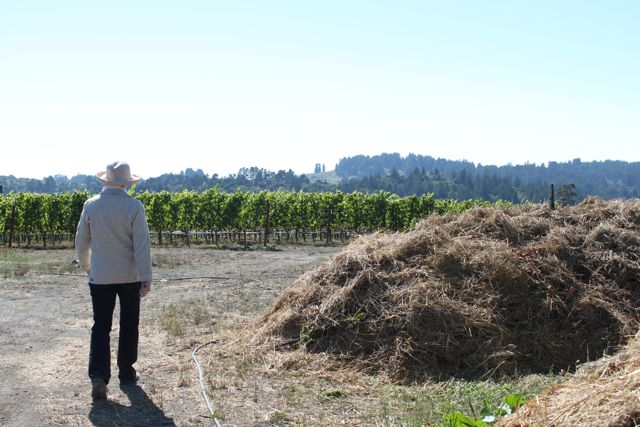Following on from the second part of our Terroir Series where we discussed the wine term ‘minerality’ (and her naysayers)…

It would be interesting to correlate the impression of saltiness found in specific wines with certain soils types, old vines and natural ferments. It seems that organic and biodynamic farming encourages organisms that break down the soil and promote strong yeast populations that help confer mineral life to the wine.
It is also surely a nonsense to say that the impression of minerality is purely caused by reductive winemaking although it may be a way of highlighting the impressions. The argument against this is the fact that oxidative wines can also seem mineral. If we were talking rough equivalence that would be one thing, but the wine expresses itself over and again in utterly discernible ways.
Minerality is certainly partly about impression and partly texture in the mouth. The descriptors I would normally associate with minerality are stoniness, metallic, shell-like, salty and earthy notes, intensified and I use that word advisedly, by focused acidity or low PH. Minerals and stones do have an intrinsic flavour, or call it, if you will, taste sensation. Consider the metallic flavour in certain wines from Friuli and Slovenia, taste the almost rusty earthiness in the Fer-influenced (iron) wines of Gaillac and Marcillac deriving from the famous rougier soils, or examine how the unique terroir on the hill of Mas de Daumas Gassac plays a role in establishing the distinctive minerality of the reds.
Some argue that the minerality one detects on the palate is a lack of fruit ripeness; in other words the absence of ripeness manifests itself as an appearance of minerality. This is a specious inference. If one examines wines from cooler climates such as Sancerre and Pouilly-Fumé (and even Marlborough) from a long growing season it is not unripeness, but rather physiological maturity, that allows the maximum expression of minerality. The same applies to warm climates such as the Roussillon. The wines of Matassa, Pithon and Roc des Anges possess extraordinary mineral structure precisely because of the alliance of terroir, old vines and physiological ripeness.

As usual the argument revolves around (or degenerates into) a cross-purposes discussion of what minerality is. The holy scripture argument is that Emile Peynaud did not use the word as if absence of evidence in one man’s language is evidence of absence! By all means let us define our terms but let us not say that those terms can’t be defined. Just as people dispute the existence and influence of terroir because it can’t be precisely calibrated so discussions inevitably boil down to what you taste and what you think you can taste. Minerality is the backbone given to the wine by the influence of the terroir; it buttresses the flavours with a determined structure.
I am indebted to Tom Lubbe (Matassa) for his comments:
I don’t think I am tasting/smelling calcium or potassium when I am drinking what I think of as a mineral wine. Minerality in wine is not for me a specific note but a sensory experience that is thrilling to the palate and beyond.
A grape is the result of its growing conditions and a vine needs a healthy, microbiologically diverse soil to absorb the naturally occurring, available mineral elements in that soil.
Wine made from well-nourished grapes has sufficient energy to not require most or any of the 200-odd wine-making add-in “aids” or props available to the modern wine-maker.
Ceasing to use chemical fertilisers and systemic chemicals which destroy soil life will see a corresponding drop in wine PH. The wine becomes noticeably fresher/more refreshing on the palate and more stable in elevage and bottle. The wine’s natural qualities of preservation are increased: i.e. it will age better. Contrary to popular belief a wine’s ageing potential is not tied to its free-sulphur levels. (Incidentally this is one mineral that is easily identified by the drinker, and I have often heard heavily sulphured wines being described as “mineral”. Usually by the winemaker.)
The wonderful thing about talking minerality is that it must eventually make people think about soil life. It is possibly true that Peynaud and others did not talk about minerality thirty years ago, but it has to be said that this was a period of terrible agricultural cretinism, the effects of which we are still suffering today. It was a period where wine-makers were taught to believe that they could make up for any physical shortcomings in their primary material by technical thuggery in the cellar. Certain media colluded to convince people that they should drink poison and like it too. Loving wine became a complex rite only understood by an initiated few (masochists). As grapes became the secondary material real flavours became absent or fleeting to be replaced by oak, residual sugar, confected “fruit” and sulphur. The mighty Sir Albert Howard talked about the relationship between minerality and flavour back in the 1920’s and 30’s, and how this was made possible, sustainably, through good composting (of course). A more sensible visionary, but who nonetheless wrongly believed that the war against “chemicals” had been won by the 1950’s!

Minerality in a wine is something that can be perceived, if not described, by the average drinker. It cannot be described by the average writer. I have heard so many people say “I love that salty finish that makes me want to drink more ….” This is usually said with a big smile. As a wine-maker (sorry) vigneron that is enough of a description of minerality for me.
The exalted impression of one characteristic is often due to the reduction of impediments. Terroir can be tricked out of a wine, the result of a systemic denaturing process. Minerality is the very backbone, the seam of a great wine; it binds the whole, it brings focus and clarity, it signifies the migration of the life of the soil into the soul of the wine.

